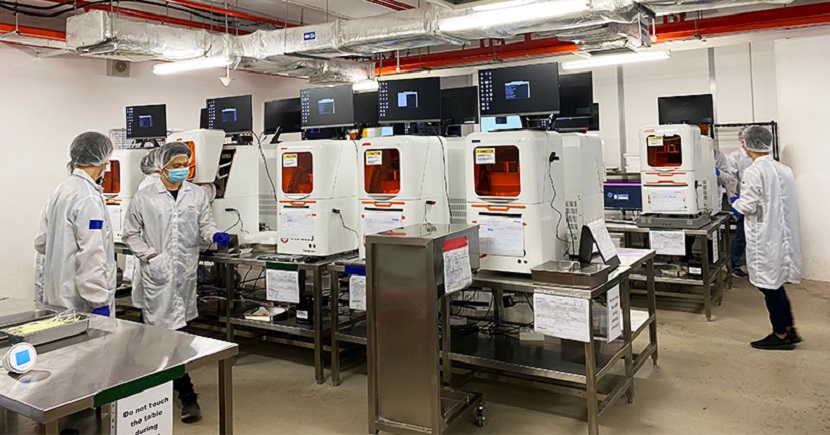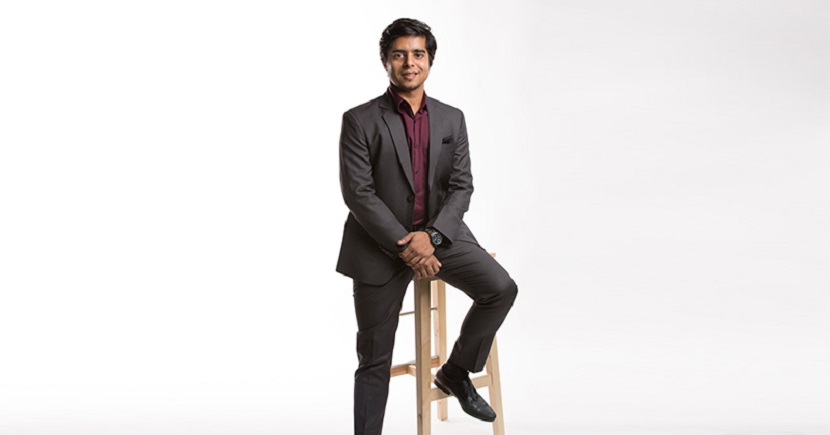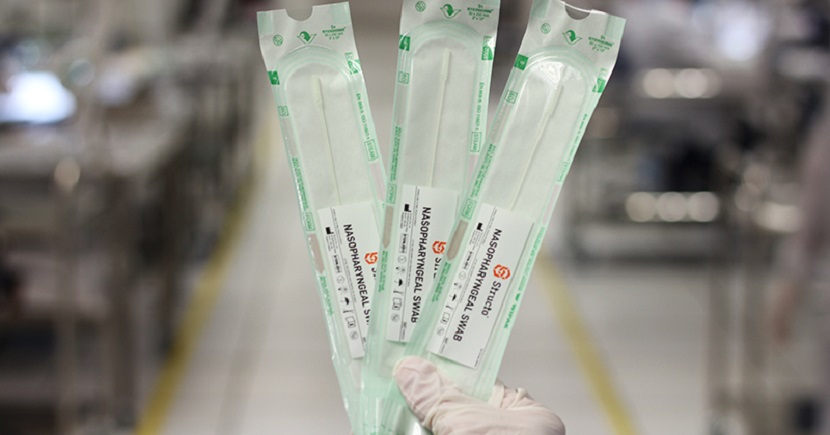First published in The Business Times on 15 September 2020.

It can feel like the founders of 3D printing solutions provider Structo were guided by serendipity. While the team knew they wanted to focus on 3D printing, it was an accidental meeting with a dentist that helped them refine their focus toward the dental field.
More recently, fate intervened in the form of Covid-19. With the soaring number of Coronavirus cases and a shortage of nasopharyngeal (NP) swabs worldwide, Structo was quick to answer the call and now manufactures swabs in addition to their mainstay.
But while serendipity might have played a part in their evolution, this startup's ability to react so quickly speaks volumes of their technical skills and understanding of the different fields they are thrown into.
Drilling down
The journey for the NUS-born 3D printing startup began in "a small room" in the National University of Singapore (NUS) in 2012 where the plan was to build an inkless printer.
The intent, a machine that used a laser to burn black marks into paper thus printing without using ink or toner; the reality, a machine that worked only half the time and caught fire the other half.
True to form, the group decided to make a pivot and shifted their focus to 3D printing instead.
"When we started 3D printing, we were riding a wave," says co-founder Devansh Sharma.
Notable milestones were being achieved in different markets in 2012. These ranged from the first 3D-printed jaw implant for an 83-year-old patient in the Netherlands to the first 3D chocolate printer, the Choc Creator, being made commercially available.
On the local front, meanwhile, Structo had developed the first prototype of mask stereolithography (MSLA) technology, which powers Structo's printers with lightning-fast print speeds and scalability.
"We were exhibiting at one of the local trade shows when a dentist came up to us and asked if our technology could work for them, albeit in a smaller form factor," says Mr Sharma.
"The machine we had built was a lot bigger because it was for generic 3D printing purposes. So to fit it into a dentist's office we had to really understand what he wanted and then redesign the whole system.
"You could say we shrank the machine from the size of a full refrigerator down to a mini fridge. So everything had to be pared down significantly."
Mr Sharma is quick to acknowledge that dentistry was a completely foreign field to them.
"We didn't know much about the use case at the time, but after talking with him a bit more, we realised he wanted to use the printer to make clear aligners.
"And, after we did some research, we realised that digital dentistry is one of the biggest 3D printing markets in the world by volume. The biggest user of 3D printing in the world then was a dental company. Today, up to 30 per cent of all the printing that's done in the world is done by dental laboratories and dentists.

"So that's something we did not know beforehand, and it was just a surprise to us, but also a good surprise because then we realised that yeah, this is something we should focus on."
While it may have been a surprise then, ask Mr Sharma now why 3D printing and dentistry are such a good fit for each other and the answer seems obvious. "Every single person's teeth are different. So you're talking about millions of unique individual parts and that's a very good match between what the market needs and what 3D printing can do. And so there's very good product market fit there," he says
Indeed, dentistry was one of the early adopters of 3D printing, particularly in the mass manufacturing space, says Mr Sharma.
Notably, the startup has clocked some significant milestones. In 2020, they celebrated two world firsts - the launch of a fully automated robotic production line capable of printing thousands of unique products per day with minimal human interaction and, on the other end of the spectrum, a gloves-free 3D printing solution.
The fully automated robotic production line is aimed at larger-scale manufacturers while the glove-free solution, Velox, is an all-in-one desktop 3D printer with autonomous post-processing aimed at dental offices.
Traditionally, when a patient goes to the dentist, the dentist will get a physical mould of the patient's teeth and arrange for an X-ray. The dentist will then send all this data back to a lab to get a surgical guide, which is essentially a medical device that the dentist relies on during the procedure.
The lab upon receiving the X-ray will then design the surgical guide digitally, print it, do the required post-processing to make sure the print is accurate and stable, dry it and cure it before shipping the final surgical guide back to the dentist. This process generally takes a few days.
A dentist with a Velox machine in their office on the other hand can take an intraoral 3D scan of their patient's teeth and submit all the data to the Velox ecosystem.
"After the dentist receives the digitally-designed surgical guide from one of our design partners, all they have to do is click 'start', and the machine will take over, wash, cure, and deliver the surgical guide within 30 to 40 minutes.
Working with the ecosystem
Structo's mission for the Velox is to continue integrating and working with industry partners in software and material sciences to provide a comprehensive ecosystem for chair-side 3D printing and covers the entire digital workflow from design to final appliance for various applications, said the company in a statement in February when it announced its integration with digital dental design service provider, evident.
Says Mr Sharma: "That's why we call it a glove-free solution - we're delivering to customers an end-to-end solution where they don't have to use any gloves or tools, click a button to start, and then print."
It's not just with Velox that the firm prizes collaboration.
"We have an internal team that specialises in automation systems and their core focus is developing and improving our capabilities.
But, for example, the robotic production line - it was a big challenge especially for us since we're a startup and this is the first time we're doing it. So we tapped on a lot of local expertise from the people who do robotic systems to system integration companies. We went as far as Malaysia to get expertise," says Mr Sharma.
Enterprise Singapore's SEEDS Capital (SC) also supported the company in the early stage of its growth, providing them access to business networks, introduction to technology partners, and facilitating linkups to potential investors. SC was was one of Structo's first institutional investors in 2016 and has continued to jointly invest in Structo with other private sector co-investment partners via several funding rounds in the past few years.
"We saw the growth potential of the company as well as the adaptability and scalability of their differentiated technology innovations, such as its industrial-grade, high-speed and high-resolution 3D printers and solutions, which were first applied in the dental space," says Geoffrey Yeo, general manager of SEEDS Capital.
"Structo's adaptability is particularly evident in its recent effort to diversify the business by adapting its 3D printing technology to cater to the production of nasopharyngeal test swabs for Covid-19, which has become an area of significant commercial interest."
As a strategic investor, Enterprise Singapore's support for startups goes beyond investment. They also connect startups to networks and resources that are critical for them to advance their business to the next level.
"More recently, when Structo was planning to diversify into the production of nasopharyngeal test swabs for Covid-19, Enterprise Singapore and SC have also engaged Structo to support them in developing the production capability of their manufacturing facility," says Mr Yeo.
Building from scratch
The decision to answer the call may have been an easy one, but gearing up for the pivot required the firm to scale up, and fast.
Earlier this year, Singapore's National Additive Manufacturing Innovation Cluster (NAMIC), with support from the National Research Foundation Singapore and in partnership with Temasek Holdings and the Economic Development Board, assembled a multi-disciplinary industry consortium to develop 3D printed nasal swabs.
At the time, demand for swabs was skyrocketing, even as one of the largest producers of these swabs in the world, Copan Diagnostics, which is located in the foothills of the Italian Alps, was facing its own Covid-19 crisis in its home country.
"So we really dived in and tried to help out in whatever way we could," says Mr Sharma. "It was a time-sensitive problem - every day people were getting infected and there's a massive impact on everything, from day-to-day life to the economy. So we decided to allocate a significant chunk of our resources to this project.
"It really is kudos to the team here and to everyone involved that we could go from design to development, clinical trials and manufacturing in under two months."

Structo is one of the manufacturers that has been manufacturing these swabs since mid-June.
"I think one of the key benefits or strengths of 3D printing is that it can scale up really quickly compared to traditional manufacturing and that's one of the key reasons why the government approached us to make these swabs.
That being said, setting up the manufacturing line was an "interesting challenge". While the engineering team was working on the design aspect, the production team had to source for an office space.
"We had to get more space and set everything up from scratch because that's not something that we had in our office pre-Covid," says Mr Sharma.
"We started off with renting a whole new floor and setting up parts of the production line. We factored in scaling the production line from zero up to a million swabs a week and now we're at the stage where we have somewhere between 300 and 400 people that we've hired for production." It helps that Structo was already operating within the dental space so their facilities are geared and designed toward crafting medical devices, notes Mr Sharma.
"So the majority of the work that we had to do was ensuring that the design of the swabs can be produced well on our printers under mass manufacturing conditions. We were aiming to produce hundreds of thousands of swabs, up to a million swabs a week, which is a large amount of manufacturing, and something that we have not done in the past."
It also helps that their machines have an intuitive interface. As such, most of the training was related to basic manufacturing skills rather than specialised 3D printing related skills.
"One thing that really helped us is that the printers we make are designed for dentists and dental technicians who don't have 3D printing or manufacturing experience. So our whole printer and software ecosystem is catered to people who know nothing about 3D printing."
Navigating the new normal
Ask Mr Sharma what's next for the company and he says "that's a tricky question to answer in these times".
But the trajectory for the company is clear.
"From a swab manufacturing perspective, we'll keep doing what we're doing as long as Singapore needs it or as long as other countries need swabs," he says.
"As for our main business, dental is something we started out with but our belief is that 3D printing encompasses a lot more than just dentistry. So we have a lot more verticals and markets we're keen to look into. But with Covid, I can't quite commit to a timeline.


